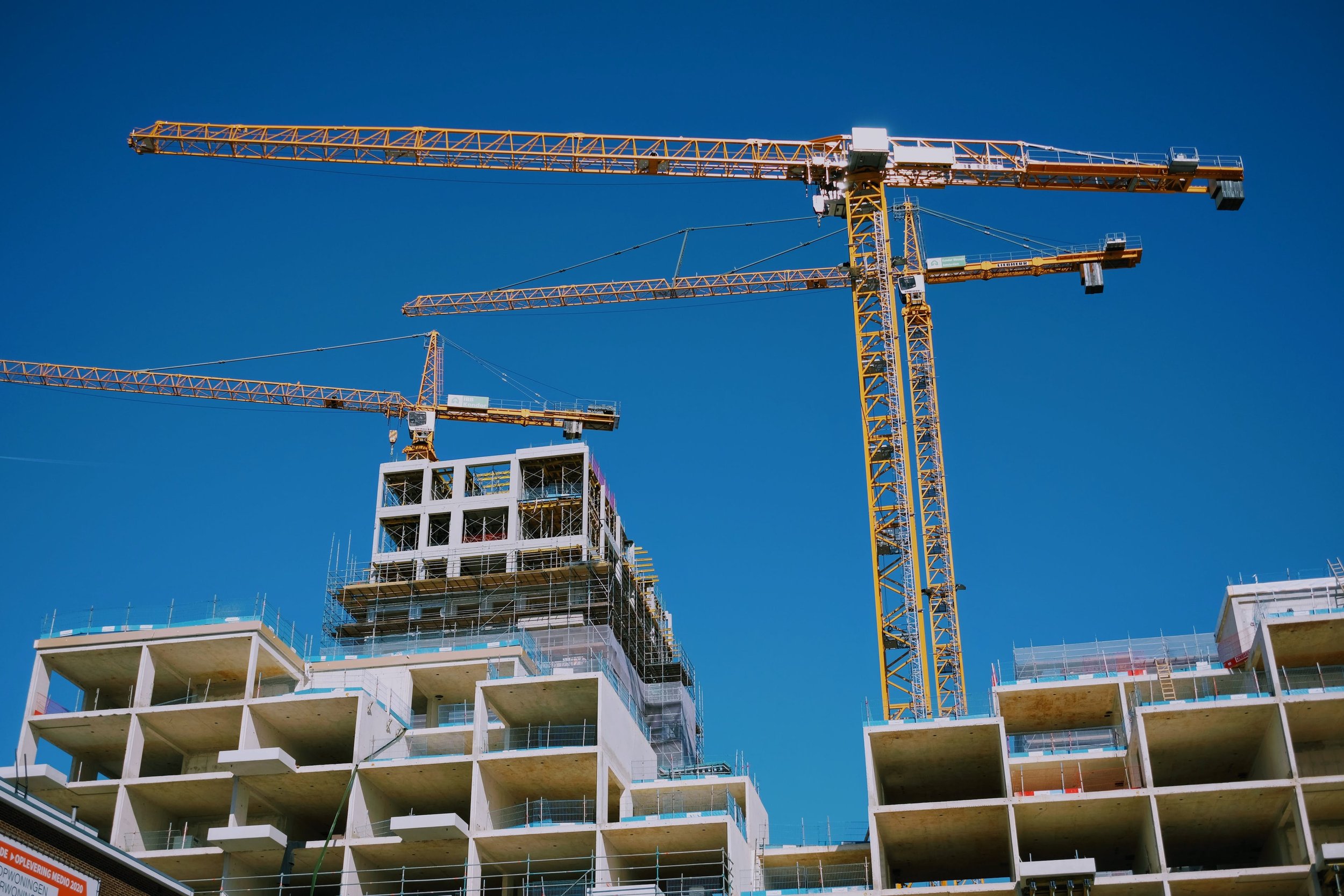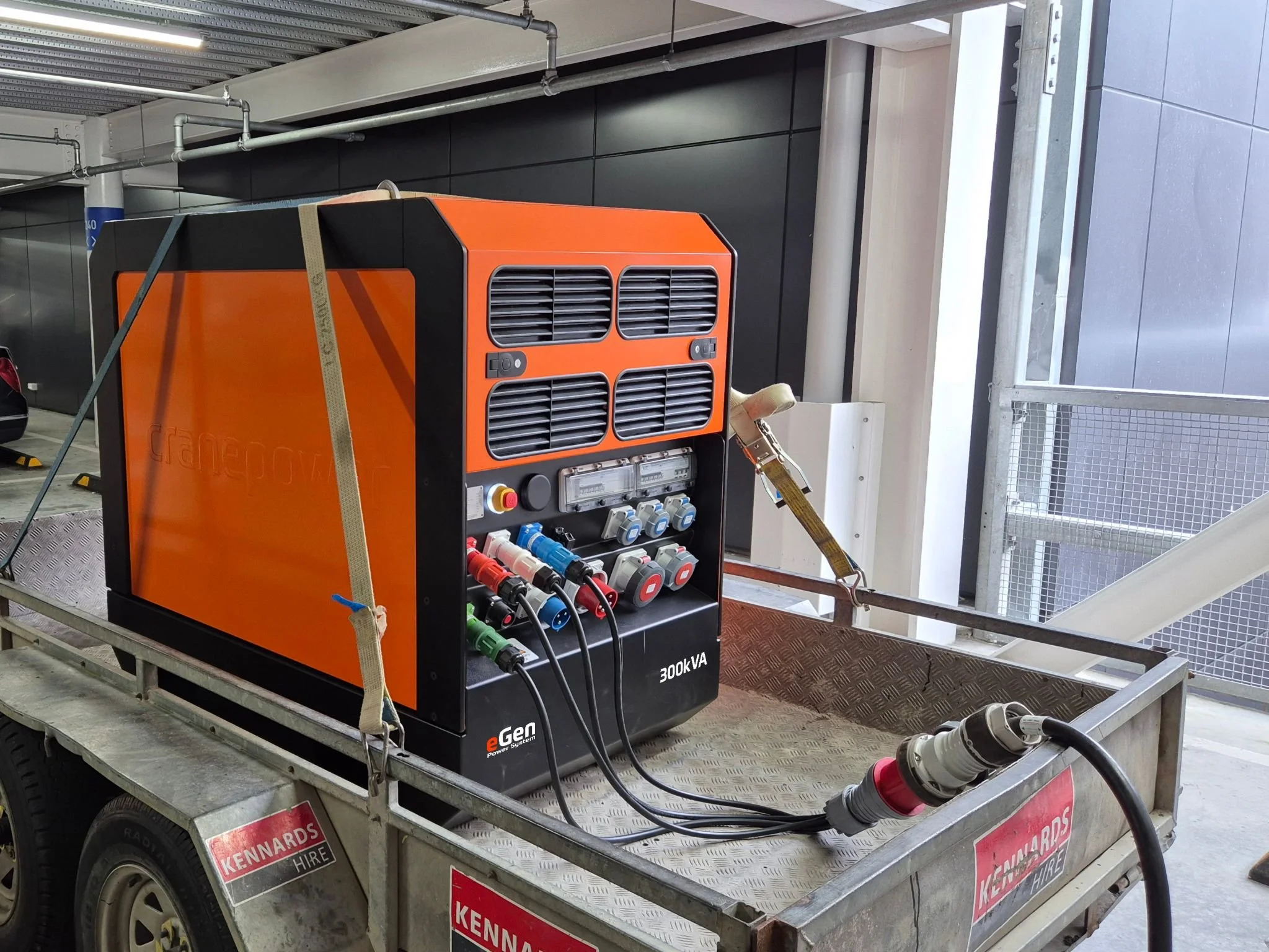
Case Studies.
No generator, no 3-phase power - no problem!
Location: 8-story apartment building by Smiths Cranes & Kalmar, Birkenhead, NZ.
Power Requirements: 265kVA Crane + General site power.
Crane Type: Liebherr 542HC-L Luffing Crane.
Input Feed: 32A, 230V, single-phase.
Model: P300.
Date: 2025.
With an 8-storey apartment complex needing to start construction, but the project being held up because of noise restrictions and no access to 3-phase site power, Kalmar Construction was under pressure to find a solution to power their tower crane and the site power.
The Liebherr 542HC-L Luffing crane, on rent from SMITH Cranes, needed a maximum of 265kVA of peak-power available for the crane, but because the site only had single-phase power available, the CP300 battery system wasn’t going to provide a solution.
After contacting us, SMITH Cranes purchased the eGen P300, which has both single-phase and 3-phase input charging, and 300kVA of peak-power, making it the perfect solution for this job.
Stud welding in the middle of a busy mall.
Location: Sylvia Park Shopping Centre, Mount Wellington, NZ.
Power Requirements: 220A, 400V, 3-phase.
Machinery Type: Stud Welder.
Input Feed: No input available.
Model: P300.
Date: 2025.
Tray-dec NZ had a small but complex stud welding job at one of the biggest malls in New Zealand.
The project had a number of constraints, such as no access to site power, so they needed a diesel generator. However, because of the location, they weren’t allowed to operate a diesel generator, and large container battery systems couldn’t access the location.
What they needed was a high-power, compact battery unit that could be trailered in with no noise pollution. The perfect job for the eGen Power System!
The stud welder would draw 220A per weld, and even after 148 studs welded that day, the battery capacity didn't drop more than 3%.
Three COMANSA Flat-Top cranes powered by one CP300.
Location: Large data centre, SMITHS Cranes & Built, Hobsonville Point, Auckland, NZ.
Power Requirements: 432kVA.
Crane Type: 3x COMANSA 21CM1100 – 144kVA.
Input Feed: 32A, 400V 3-phase.
Annual CO2 Reduction: 308,000kg.
Model: CP300.
Date: 2024.
The original plan for this site was to put a 200kVA generator on each of the three cranes, but SMITH cranes suggested the site uses a single CP300 as a solution to powering all three cranes instead.
With 32A input feed into the CP300, and an output feed of 440A to a switch board, the CP300 was able to power all three cranes from the distribution board. For over 12 months, the CP300 has powered all three cranes with zero downtime, barely dropping below 70% on the busiest day.
A further benefit of the CP300 over diesel generators was the 24/7 availability of power. The generators are unable to be used during night times or weekends, which would have caused the cranes to lose power during these times, meaning safety lights wouldn’t work.
Thousands saved by replacing two diesel generators with a CP300.
Location: Six-story car park by SMITHS Cranes, East Tamaki, NZ.
Power Requirements: 300kVA.
Crane Type: COMANSA 21CM1100 – 144kVA and TEREX CTT721 – 200kVA.
Input Feed: 32A, 400V 3-phase.
Annual CO2 Reduction: 219,000kg.
Model: CP300.
Date: 2023.
SMITHS Cranes was contracted to construct a six-story car park and factory, requiring the installation of two flat-top tower cranes: the COMANSA 21CM1100 – 144kVA and TEREX CTT721 – 200kVA. However, the site did not have a power supply available from the mains. Smiths Cranes had planned to install two 300kVA diesel generators to power the cranes which have a peak power draw of 420A.
Upon learning about Cranepower's product, they opted to install a single CP300 unit to power both cranes, instead of the generators. The use of the CP300 unit instead of two diesel generators not only saved the company hundreds of thousands of dollars, it also saved space on the construction site and reduced the project's carbon footprint by 219 tonnes annually, helping the company achieve its sustainability goals.
Powering New Zealand’s largest crane – Kroll 1650L.
Location: Commercial building by Smiths Cranes & Naylor Love, Albany, NZ.
Power Requirements: 300kVA.
Crane Type: Kroll 1650L – 320kVA.
Input Feed: 32A, 400V, 3-phase.
Annual CO2 Reduction: 180,000kg.
Model: CP300.
Date: 2023.
Our CP300 was chosen to power NZ’s largest tower crane on a critical Naylor Love project, saving 15 tonnes of CO2 each month.
Transformer delays on this Naylor Love project left them scrambling to find a power solution for the large Kroll 1650L tower crane. Smith Cranes presented Naylor Love with two options: a 450kVA generator running 60 hours a week and burning over 1000L of diesel each week, or a CP300 that simply plugs into their existing general site power.
Naylor Love immediately chose the CP300 option as it was cheaper, quieter, and better for the environment than the diesel generator option. The CP300 gave Naylor Love a low-emission way to stay on schedule.
Successfully reduced noise and emissions by over 80,000kg.
Location: Retirement village by Kalmar Construction, Kerikeri, NZ.
Power Requirements: 150kVA.
Crane Type: Liebherr 200 EC-B 10 - 90kVA.
Input Feed: 16A, 400V, 3-phase.
Annual CO2 Reduction: 80,000kg.
Model: CP300x.
Date: 2023.
Kalmar Construction were building a retirement village in Kerikeri, a beautiful small town in the north of New Zealand. They needed to power a Liebherr 200 EC-B 10 crane, installed at the centre of the site. Originally, they had planned to use a 200kVA diesel generator for the job. However, after learning about the advantages of the Cranepower units, they decided to switch to a Cranepower CP300.
Despite only drawing 16A of power from the general site power, the Cranepower CP150 provided reliable and consistent power to the crane. By using the CP300, Kalmar was able to reduce their CO2 emissions by approximately 80 tonnes per year while increasing their productivity and saving money.
Successfully reduced noise and emissions by over 185,000kg.
Location: 11-story hotel site by Safari Group, Ellerslie, NZ.
Power Requirements: 300kVA.
Crane Type: JASO J280PA - 200kVA.
Hoists: 2 x 50kVA.
Input Feed: 32A, 400V, 3-phase.
Annual CO2 Reduction: 186,000kg.
Model: CP300x.
Date: 2021.
Construction & development company Safari Group installed a CP300 system in 2021 to power a JASO J280 luffing crane and two 50kVA personnel hoists on a commercial construction site in Ellerslie, Auckland. The CP300 was fed by a single 32A feed.
The large, European-made JASO crane has a peak load over 200kVA, and the hoists required a further 100kVA. This would have required a 500kVA diesel generator or 400A grid feed to be installed in the centre of the site. Both these options were impractical and expensive. Additionally, the site was situated within an established business park, meaning noise and environmental impacts needed to be kept to a minimum.
By using the CP300 system, Safari Group has been able to significantly reduce installation and operational costs while simultaneously maintaining low levels of noise and reducing the site carbon footprint by over 180 tonnes in the first year of operation.
250kVA diesel generator replaced by CP300 zero-emission option.
Location: Multi-story medical centre by Cassidy Construction, Remuera, NZ.
Power Requirements: 150kVA.
Crane Type: Terex CTL-260 - 165kVA.
Input Feed: 16A, 400V 3-phase.
Annual CO2 Reduction: 84,000kg.
Model: CP300.
Date: 2024.
Cassidy Construction needed to find a way to power the Terex CTL-260 luffing tower crane on a project in Remuera, Auckland. The grid connection was not large enough to support the crane. Instead of taking the traditional approach and installing a 200kVA generator for the crane, Cassidy chose the CP300 and simply plugged it into their existing temporary site power supply, eliminating the need for a generator all together.
Cassidy are saving money, reducing noise and fumes and are preventing 7 tonnes of CO2 emissions each month.
Successfully reduced the sites carbon footprint by over 185,000kg.
Location: 11-story Highrise building by Watts & Hughes Construction, Auckland CBD, NZ.
Power Requirements: 300kVA.
Crane Type: POTAIN MCR 295, 220kVA, luffing crane.
Hoists: 40kVA personnel hoist.
Input Feed: 16A, 400V, 3-phase.
Annual CO2 Reduction: 185,000kg.
Model: CP300.
Date: 2023.
Watts & Hughes were constructing a building in Auckland CBD and had been using two diesel generators to power their tower crane and personnel hoist for the past 2 years. The generators were causing constant problems with noise, diesel fumes and complaints from neighbours. The site had a 63A builders temporary supply which was used for general site power and site offices.
To address the noise and emissions problems caused by the generators, Watts & Hughes installed a CP300 in April 2023 to provide power to both the tower crane and the personnel hoist. The CP300 was set to only draw 16A from the general site power and was plugged into one of the site power distribution boxes. The use of the CP300 system has had several positive results for Watts & Hughes. First, it has helped them reduce noise and emissions on the construction site, which has improved relations with their neighbours. Second, the CP300 system has provided reliable and efficient power to the tower crane and personnel hoist, which has improved productivity and reduced downtime. Third, the use of the CP300 system has helped them reduce their operational costs by eliminating the need for two diesel generators. Finally, the use of the CP300 system has helped them reduce their carbon footprint by over 185 tonnes annually.
Download the eGen brochure below

Here to support your temporary power needs.
info@cranepower.com
sales@cranepower.com
+64 21 227 24 24

















